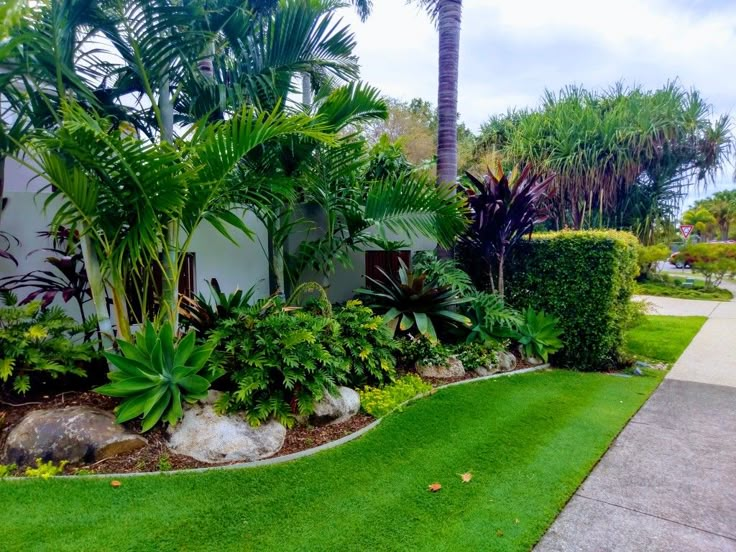The 2025 Landscaping Renaissance: Why It Matters Now More Than Ever
In 2025, landscaping is no longer a luxury—it’s an expression of lifestyle, sustainability, and value. Homeowners across the U.S. are reimagining their outdoor spaces, not just to increase property value, but to reconnect with nature, foster biodiversity, and create beautiful havens for rest, play, and gathering.
Whether you have a sprawling lawn or a modest courtyard, landscaping now integrates ecology, style, and purpose. It’s not just about planting a few shrubs anymore. It’s about sculpting an ecosystem that reflects your values.
💬 “A well-landscaped home can increase property value by up to 15% in 2025,” says Jill Eddington, Landscape Architect and CEO of GreenNest Studio.
Key Principles of Beautiful Landscaping in 2025
Let’s break down what truly defines “beautiful” landscaping in this era of eco-conscious design:
1. Harmony With Nature
Gone are the days of rigid symmetry and imported plants. In 2025, landscaping beauty comes from balance—with the local climate, soil, and ecosystems. Native and drought-resistant plants are leading the way.
2. Functional Flow
A stunning landscape should also be functional: walking paths that encourage movement, shaded sitting zones, edible gardens, and even meditation nooks. Every element must serve a purpose and elevate beauty.
3. Low-Maintenance Intelligence
Smart irrigation systems, automated lighting, and mulch-based weed control allow for effortless upkeep. Landscapes are now designed to work for you—not against your calendar.
Trend Watch: What’s Driving Landscaping in 2025?
Let’s explore what’s shaping the industry and influencing consumer preferences this year.
💡 Smart Tech Integration
-
App-controlled irrigation systems
-
Soil moisture sensors
-
Solar-powered garden lights
🌎 Sustainability First
-
Permeable pavers to reduce runoff
-
Organic fertilizers only
-
Recycled water systems for irrigation
📦 Modular Design
Homeowners prefer phased landscaping with modular zones—making it budget-friendly and adaptable over time.
🪵 Biophilic Design
Integrating natural textures—stone, raw wood, living walls—helps blend indoor-outdoor boundaries for a seamless visual experience.
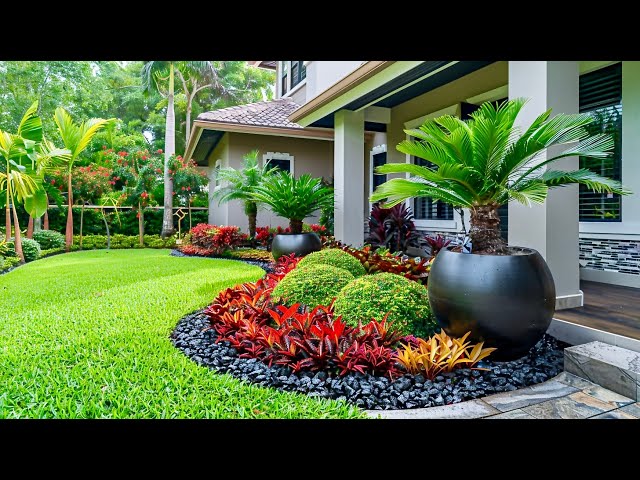
best garden in the world
Common Landscaping Mistakes (and How to Avoid Them)
Before grabbing a shovel, beware of these errors:
| Mistake | Why It Hurts Your Yard | What to Do Instead |
|---|---|---|
| Overplanting | Creates chaos and maintenance overload | Follow a scaled planting plan with spacing guides |
| Ignoring soil health | Poor soil leads to stressed plants | Get a professional soil test before planting |
| Using invasive species | Harms local biodiversity | Choose native or well-adapted plants |
| Forgetting sun/shade balance | Plants may burn or starve | Track sunlight patterns before placement |
| Skipping drainage planning | Leads to root rot and erosion | Install a drainage system or grading |
Designing With Climate in Mind
One of the most defining aspects of landscaping in 2025 is climate-consciousness. Water-wise design is essential—especially in states like California, Texas, and Nevada. The EPA continues to emphasize outdoor water use as a primary conservation target.
Top Water-Wise Practices:
-
Xeriscaping (using drought-tolerant plants)
-
Drip irrigation instead of sprinklers
-
Rain barrel collection systems
-
Shade-tree placement for natural cooling
🔗 Backlink: EPA WaterSense Landscaping Tips (2025)
Case Study: A Suburban California Oasis
Meet the Johnson family from Santa Clara, CA. In 2024, they replaced their thirsty lawn with a native pollinator garden, winding flagstone paths, and a shaded patio covered in jasmine and vines.
Their Goals:
-
Reduce water usage by 50%
-
Attract bees and butterflies
-
Build a kid-safe zone without toxic plants
The Result:
-
Water bill dropped by 61%
-
Yard certified as a wildlife habitat
-
Low-maintenance with 4 hours of care/month
💬 “It feels like a retreat now. We see hummingbirds every day,” says homeowner Dana Johnson.
Landscape Planning 101: Where to Begin
Most failed landscape attempts begin with… not planning at all. A great design is intentional and layered. Here’s how to map your vision:
Step 1: Audit Your Yard
-
What’s the sun/shade pattern?
-
Is the soil clay-heavy, sandy, or loamy?
-
Any drainage issues or slopes?
Step 2: Define Your Zones
Use zones to create functionality:
-
Entertaining zone (deck, firepit)
-
Quiet zone (bench, pergola, trees)
-
Productive zone (herbs, raised beds)
-
Play zone (grass patch, sandbox)
Step 3: Match Plants to Microclimates
Group sun-loving plants together, and place shade-lovers under tree canopies or behind tall structures.
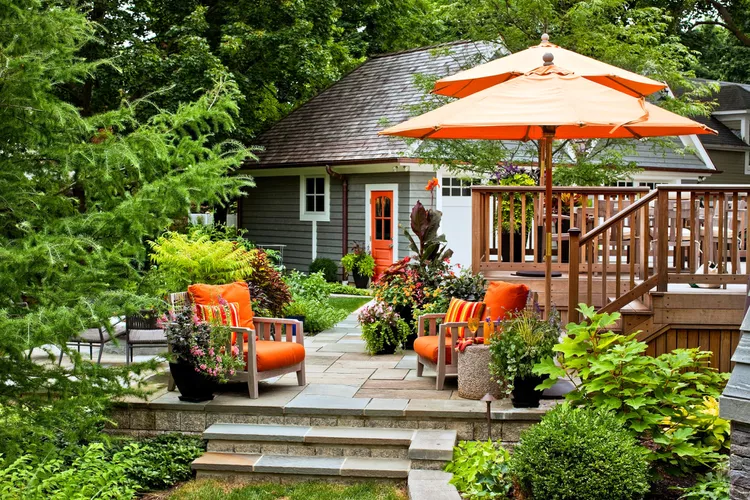
backyard-deck-orange-umbrellas
[Table 1: Landscaping Cost Breakdown by Project Type – 2025]
| Project Type | DIY Estimated Cost | Professional Install | Maintenance/Year |
|---|---|---|---|
| Lawn to Xeriscape | $2,500 | $7,000 | $200 |
| Patio & Firepit | $1,800 | $6,500 | $150 |
| Native Plant Garden | $1,200 | $4,000 | $100 |
| Water Feature (Small) | $800 | $3,000 | $300 |
| Outdoor Lighting System | $700 | $2,200 | $50 |
Expert Voices: What Makes a Landscape Timeless?
💬 “Great landscaping tells a story. It blends your lifestyle, your local ecology, and your future needs,” says Marisol Vega, Lead Designer at EcoScape Studio.
💬 “The best landscapes don’t just look great in spring. They’re alive and interesting year-round,” shares Rico Delgado, horticulturalist and author of “Living Spaces, Growing Dreams”.
Top Tools & Apps for Landscape Planning in 2025
-
iScape App: Augmented reality for visualizing plants
-
Plan-A-Garden (Better Homes & Gardens): Free drag-and-drop designer
-
SmartPlant: Plant care alerts tailored to your location
🔗 Backlink: Better Homes & Gardens Landscaping Planner
The Art of Balance: Softscape Meets Hardscape
A truly beautiful landscape strikes the perfect harmony between softscape (living elements) and hardscape (non-living, structural components). Without this balance, a yard either feels like a wild jungle or a concrete wasteland.
Softscape Examples:
-
Trees, shrubs, perennials, annuals
-
Ground covers, grasses, vines
-
Garden beds, edible gardens
Hardscape Examples:
-
Stone paths, patios, retaining walls
-
Pergolas, decks, fences
-
Outdoor kitchens, fire pits, water features
💬 “Think of softscape as the soul of your landscape, and hardscape as the skeleton,” explains landscape architect Drew Lamont of EarthForm Studios.
Creating Flow: Paths, Lighting & Water Features
1. Paths that Guide the Eye and the Feet
Curved or staggered pathways naturally guide people through your landscape, creating curiosity and exploration. Use materials like:
-
Crushed granite (budget-friendly)
-
Flagstone (natural look)
-
Brick or cobblestone (classic charm)
🔗 Backlink: Houzz Guide: Best Walkway Materials for 2025
2. Outdoor Lighting: Layered & Intentional
Gone are the days of one solar light per bush. In 2025, lighting follows a layered approach:
-
Ambient: String lights or lanterns
-
Task: Step or path lights
-
Accent: Uplighting for trees, downlighting for sculptures
💡 Use motion-activated LED lighting for energy efficiency and security.
3. Water Features: Movement + Sound = Magic
Whether it’s a small bubbling fountain or a koi pond, water features elevate tranquility and support local wildlife.
-
Reflective pools add elegance
-
Waterfalls add sound + visual interest
-
Birdbaths invite biodiversity
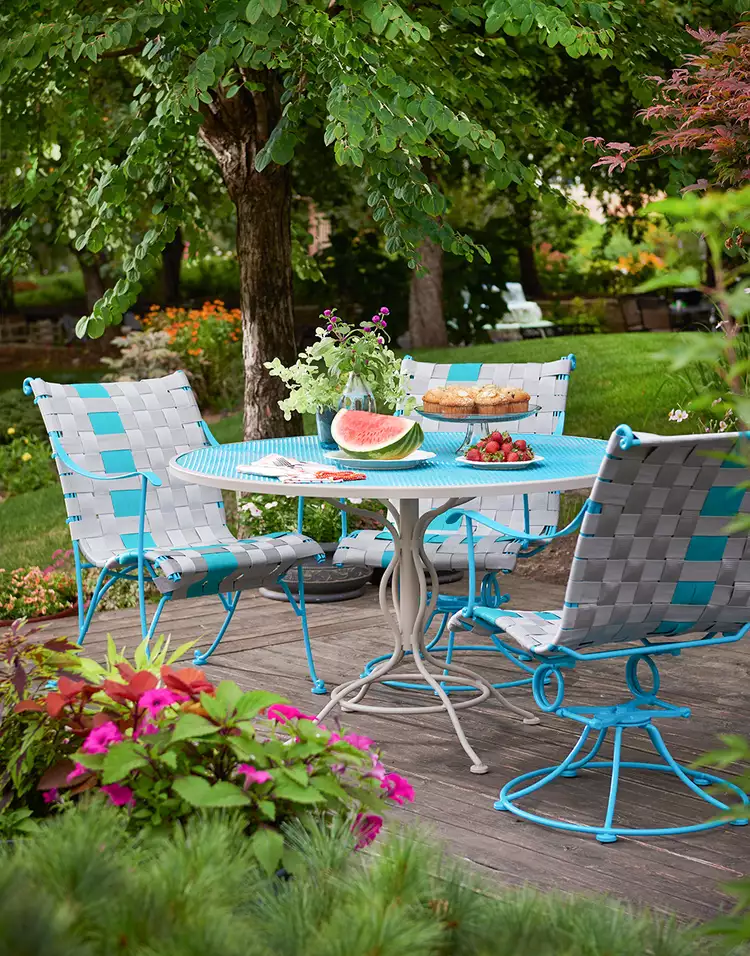
refinished-rustic-patio-furniture
Garden Zoning: Making Space Work Smarter
Think of your yard in zones, much like you’d design rooms in a home.
🍽️ Entertaining Zone:
-
Paver patio or deck
-
Built-in seating or fire pit
-
Shade structures like pergolas or sails
🧘 Relaxation Zone:
-
Hammocks, loungers, meditation corners
-
Surrounded by calming plants (lavender, bamboo)
-
Soft lighting, wind chimes, water sounds
🌻 Pollinator Zone:
-
Milkweed, bee balm, echinacea, native grasses
-
Designed with bloom sequences for year-round support
🥕 Edible Zone:
-
Raised beds, container gardens, fruit trees
-
Can be beautifully blended with ornamentals
🔗 Backlink: Audubon Native Plant Guide
Smart Irrigation Systems for 2025 Landscapes
Modern landscapes are efficient. These tools optimize water usage and cut maintenance:
-
Drip Irrigation: Precise watering to roots
-
Soil Moisture Sensors: Prevent overwatering
-
App-Connected Controllers: Adjust based on weather
💬 “Smart irrigation can reduce water waste by 30–50%,” notes Nate Rosenthal, irrigation consultant with EcoDrop Systems.
DIY vs Hiring a Professional: Where It Counts
| Project Type | Best Done DIY | Better with a Pro |
|---|---|---|
| Raised garden beds | ✅ | |
| Drip irrigation install | ✅ (with guides) | |
| Retaining wall >3ft | ✅ Structural safety | |
| Hardscaping patios | ⚠️ (if skilled) | ✅ Longevity & grading |
| Outdoor lighting design | ✅ Basic kits | ✅ For layered/automated systems |
| Native planting plan | ✅ w/ research | ✅ For large areas or complex zoning |
🎯 Tip: Combine both. Start with a pro consultation, then handle the manageable work yourself to save costs.
Sustainable Materials You Should Know
In 2025, materials must do more than just look good—they must last, support sustainability, and fit your local environment.
[Table 2: Top Landscaping Materials – Pros, Cons, Costs]
| Material | Pros | Cons | Avg. Cost (per sq ft) |
|---|---|---|---|
| Reclaimed wood | Eco-friendly, rustic charm | Needs sealing | $6–$12 |
| Composite decking | Long life, low-maintenance | Plastic feel | $9–$14 |
| Natural flagstone | Organic look, durable | Costly, heavy | $12–$20 |
| Gravel/crushed rock | Affordable, great drainage | Can shift over time | $1–$3 |
| Concrete pavers | Versatile, budget-friendly | Can crack | $4–$8 |
Step-by-Step: Designing Your Dream Front Yard
Let’s walk through a basic process for designing a stunning, curb-appeal-boosting front yard.
Step 1: Choose a Focal Point
-
Tree, sculpture, water feature, or arched gate
Step 2: Frame with Plants
Use taller shrubs at the back and taper down toward the path/sidewalk.
Step 3: Define the Entry Path
Use contrast—dark mulch, lighter pavers—to draw the eye to the door.
Step 4: Mix Textures
Pair soft grasses with sculptural agave or boxwood for visual variety.
Step 5: Add Lighting
Highlight your focal point, steps, and any dramatic trees or accents.
🔗 Backlink:The Spruce – Front Yard Landscaping Ideas
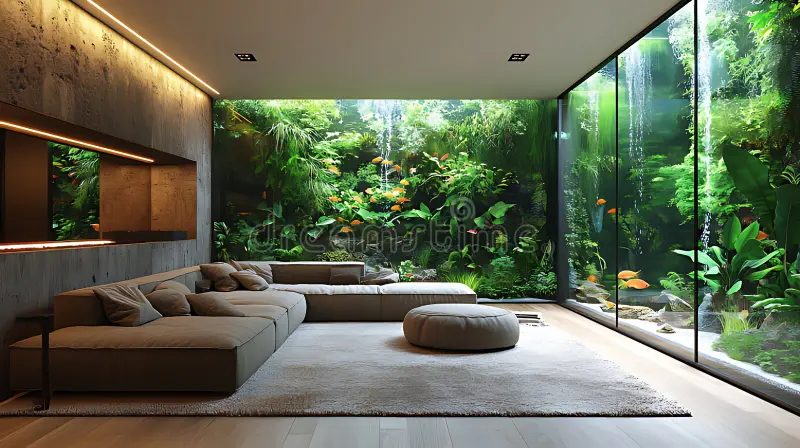
modern-living-room-indoor-waterfall-lush-plants-fish-tank-relaxation-373694797
Seasonal Design Cycles: Planning Across the Year
In 2025, landscape design isn’t “one and done.” It’s layered across seasons.
| Season | Focus | Suggested Action |
|---|---|---|
| Winter | Planning & prep | Test soil, design layout, order seeds |
| Spring | Plant & build | Install hardscape, sow new beds |
| Summer | Maintenance & enjoy | Prune, mulch, harvest edibles |
| Fall | Revise & enrich | Add compost, adjust planting plan |
🛠️ Pro Tip: Fall is the best time to plant trees and perennials for root establishment.
Design Psychology: Color and Texture
In 2025, landscape design borrows from color theory and spatial psychology to create mood.
Color Ideas:
-
Cool colors (blue, lavender, green): Calming and spacious
-
Warm colors (red, orange, yellow): Energizing and cozy
Texture Tips:
-
Use a mix of fine (ferns, ornamental grasses), medium (roses, herbs), and bold textures (hostas, agaves) to add depth.
🎯 Combine color + texture zones to create emotion and movement in your landscape.
From Dream to Reality: Installation in Phases
Trying to do everything at once is overwhelming. Break your project into three strategic phases to stay on budget and on track.
🧱 Phase 1: Foundation & Infrastructure
-
Grading, drainage fixes
-
Installing irrigation systems
-
Laying hardscapes (paths, patios)
🌳 Phase 2: Trees, Shrubs & Structural Plants
-
Planting focal trees, evergreen borders
-
Placing large shrubs for shape and privacy
-
Adding soil amendments, mulch, compost
🌼 Phase 3: Flowers, Beds, Decorative Features
-
Annuals, perennials, edible plants
-
Outdoor lighting, art, water elements
-
Furniture, planters, seasonal décor
💬 “The key to a beautiful and lasting landscape is pacing yourself,” advises garden planner Sierra Holt of GardenVista Design.
Low-Cost, High-Impact Landscaping Hacks
Not every yard needs a five-figure transformation. Use these affordable upgrades with maximum wow:
| Tip | What to Do | Cost |
|---|---|---|
| Mulch It | Use dark mulch for a clean, modern finish | $3–$5 per bag |
| Paint Your Fence | A black or deep green backdrop makes plants pop | $25–$60 |
| Solar Uplights | Place under trees or statues for drama | $5–$10 per light |
| Divide Perennials | Multiply your plants for free! | Free |
| Edging Beds | Sharp lines between lawn and beds = pro look | $20 (manual tool) |
🔗 Backlink: Better Homes & Gardens – Cheap Landscaping Ideas
Landscaping for Small or Urban Spaces
Even a tiny balcony or courtyard can become a green retreat.
1. Go Vertical
-
Wall planters
-
Hanging pots
-
Trellises with vines (jasmine, clematis)
2. Multi-Use Furniture
-
Benches with storage
-
Raised beds that double as seating
3. Use Mirrors or Reflective Panels
To visually expand space and reflect plant beauty.
4. Container Strategy
-
Group containers in odd numbers (3, 5, 7)
-
Mix heights and textures
-
Use color-coded pots for harmony
Common Landscaping Mistakes to Avoid
-
Ignoring Sunlight Requirements
→ Always check plant tags or local guides. -
Overplanting
→ Plants grow. Leave room for maturity. -
No Focal Point
→ Every yard needs a visual anchor. -
Too Many Materials
→ Stick to 2–3 hardscape materials for cohesion. -
Poor Drainage
→ Water damage ruins roots and hardscapes.
⚠️ Pro Insight: “Ninety percent of failed landscapes we see stem from poor planning in drainage and spacing,” warns Tina Marshall, senior consultant at TerraDesign Collective.
Maintenance Plan: Keeping Your Yard Glorious Year-Round
| Task | Frequency | Notes |
|---|---|---|
| Watering | 1–3x/week | Adjust by season & rainfall |
| Weeding | Weekly | Use mulch to suppress |
| Pruning | Seasonally | Trees in winter, shrubs post-bloom |
| Fertilizing | Spring & Fall | Use slow-release organics |
| Mulching | 1–2x/year | Maintain 2–3 inch layer |
| Lawn Mowing | Weekly (summer) | Vary direction to protect roots |
🔗 Backlink: University Extension Lawn Maintenance Guide
Expert Tips for 2025 Landscapes
-
Native plants = lower water use, less maintenance, and higher pollinator support
-
Compost tea is gaining traction as a natural fertilizer and disease booster
-
Use shade sails instead of building expensive gazebos
-
Invest in automated drip systems with rain sensors
-
For privacy, choose green screens like bamboo or arborvitae
Full Landscaping Checklist for Homeowners (2025 Edition)
✅ Test your soil (pH, drainage)
✅ Sketch zones: entry, living, play, utility, shade
✅ Choose focal points
✅ Set a budget range
✅ Research plants for your zone (USDA or Sunset Zone)
✅ Select lighting & irrigation systems
✅ Choose sustainable materials
✅ Plan for year-round visual interest
✅ Build in phases
✅ Schedule monthly maintenance reminders
Product Picks for 2025: Tools & Essentials
| Product | Why It’s Great | Link |
|---|---|---|
| Rain Bird ST8i-WiFi Irrigation Controller | App-based smart watering | RainBird.com |
| Gardener’s Supply Modular Raised Beds | Expandable and attractive | Gardeners.com |
| DeWitt Weed Barrier Pro | Durable, eco-friendly | Amazon – Link |
| Black+Decker Cordless Hedge Trimmer | Lightweight, long battery life | HomeDepot |
Frequently Asked Questions (FAQ)
Q1: What is the cheapest way to landscape my backyard?
A: Use mulch, native plants, and DIY raised beds. Divide existing perennials and edge beds for free.
Q2: Is artificial turf a good idea in 2025?
A: Only in arid zones with strict water rules. Elsewhere, it may overheat and harm soil health.
Q3: Should I hire a landscape designer?
A: For complex, large-scale projects—yes. For simple updates, you can do a lot with planning apps and online tools.
Q4: What plants require the least maintenance?
A: Look for native grasses, sedums, lavender, hostas, and coneflowers.
Q5: What are the biggest trends in 2025 landscaping?
A: Water-wise design, native pollinator zones, edible landscapes, and minimalist hardscaping.
Conclusion: Cultivate Beauty with Intention
Landscaping is more than aesthetics—it’s a declaration of how you live, what you value, and how you treat the environment. Whether you’re building a pollinator paradise, a cozy outdoor living room, or a tranquil path to peace, every inch of green you plant gives something back.
Design your yard not just to impress the neighbors—but to restore your spirit and create a space you never want to leave.
🌱 “The best time to plant a tree was 20 years ago. The second best time is now.” — Chinese Proverb
🎥 Bonus: Watch This Full 2025 Landscaping Walkthrough
👉


